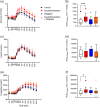Acute effects on glucose tolerance by neprilysin inhibition in patients with type 2 diabetes
- PMID: 35676803
- PMCID: PMC9545540
- DOI: 10.1111/dom.14789
Acute effects on glucose tolerance by neprilysin inhibition in patients with type 2 diabetes
Abstract
Aims: Sacubitril/valsartan is a neprilysin-inhibitor/angiotensin II receptor blocker used for the treatment of heart failure. Recently, a post-hoc analysis of a 3-year randomized controlled trial showed improved glycaemic control with sacubitril/valsartan in patients with heart failure and type 2 diabetes. We previously reported that sacubitril/valsartan combined with a dipeptidyl peptidase-4 inhibitor increases active glucagon-like peptide-1 (GLP-1) in healthy individuals. We now hypothesized that administration of sacubitril/valsartan with or without a dipeptidyl peptidase-4 inhibitor would lower postprandial glucose concentrations (primary outcome) in patients with type 2 diabetes via increased active GLP-1.
Methods: We performed a crossover trial in 12 patients with obesity and type 2 diabetes. A mixed meal was ingested following five respective interventions: (a) a single dose of sacubitril/valsartan; (b) sitagliptin; (c) sacubitril/valsartan + sitagliptin; (d) control (no treatment); and (e) valsartan alone. Glucose, gut and pancreatic hormone responses were measured.
Results: Postprandial plasma glucose increased by 57% (incremental area under the curve 0-240 min) (p = .0003) and increased peak plasma glucose by 1.7 mM (95% CI: 0.6-2.9) (p = .003) after sacubitril/valsartan compared with control, whereas postprandial glucose levels did not change significantly after sacubitril/valsartan + sitagliptin. Glucagon, GLP-1 and C-peptide concentrations increased after sacubitril/valsartan, but insulin and glucose-dependent insulinotropic polypeptide did not change.
Conclusions: The glucose-lowering effects of long-term sacubitril/valsartan treatment reported in patients with heart failure and type 2 diabetes may not depend on changes in entero-pancreatic hormones. Neprilysin inhibition results in hyperglucagonaemia and this may explain the worsen glucose tolerance observed in this study.
Clinicaltrials: gov (NCT03893526).
Keywords: GLP-1; clinical trial; drug mechanism; glucagon; glycaemic control.
© 2022 The Authors. Diabetes, Obesity and Metabolism published by John Wiley & Sons Ltd.
Conflict of interest statement
NJWA has received speaker fees from MSD as subsidiary of MERCK and Mercodia, research support from Novo Nordisk A/S and Mercodia. CFD has received consultancy/lecture fees from companies with an interest in developing and marketing incretin‐based therapies for treatment of type 2 diabetes (Boehringer Ingelheim, Lilly, Merck/MSD, Novo Nordisk). Spouse holds stock in Merck/MSD. JJH and LLG are members of advisory boards for Novo Nordisk A/S and has received lecture fees from the same company. Other authors declare that they have no competing interests.
Figures



Similar articles
-
Circulating Concentrations of C-Type Natriuretic Peptides Increase with Sacubitril/Valsartan Treatment in Healthy Young Men.Clin Chem. 2022 May 18;68(5):713-720. doi: 10.1093/clinchem/hvac005. Clin Chem. 2022. PMID: 35175317 Clinical Trial.
-
Effect of sacubitril/valsartan versus enalapril on glycaemic control in patients with heart failure and diabetes: a post-hoc analysis from the PARADIGM-HF trial.Lancet Diabetes Endocrinol. 2017 May;5(5):333-340. doi: 10.1016/S2213-8587(17)30087-6. Epub 2017 Mar 18. Lancet Diabetes Endocrinol. 2017. PMID: 28330649 Free PMC article. Clinical Trial.
-
Activation of GLP-1 receptor signalling by sacubitril/valsartan: Implications for patients with poor glycaemic control.Int J Cardiol. 2022 Nov 15;367:81-89. doi: 10.1016/j.ijcard.2022.08.015. Epub 2022 Aug 6. Int J Cardiol. 2022. PMID: 35944765 Review.
-
Combined Angiotensin Receptor Antagonism and Neprilysin Inhibition.Circulation. 2016 Mar 15;133(11):1115-24. doi: 10.1161/CIRCULATIONAHA.115.018622. Circulation. 2016. PMID: 26976916 Free PMC article. Review.
-
Angiotensin-Neprilysin Inhibition in Acute Decompensated Heart Failure.N Engl J Med. 2019 Feb 7;380(6):539-548. doi: 10.1056/NEJMoa1812851. Epub 2018 Nov 11. N Engl J Med. 2019. PMID: 30415601 Clinical Trial.
Cited by
-
Pseudo-nephropathy and hyper-excretion of urinary C-peptide: an overlooked adverse effect of an angiotensin receptor-neprilysin inhibitor (ARNI).Diabetol Int. 2024 May 28;15(3):616-620. doi: 10.1007/s13340-024-00730-9. eCollection 2024 Jul. Diabetol Int. 2024. PMID: 39101167 Free PMC article.
-
Impact of the angiotensin receptor-neprilysin inhibitor in clinical diabetes management: Potential benefits and pitfalls.J Diabetes Investig. 2023 Sep;14(9):1038-1040. doi: 10.1111/jdi.14044. Epub 2023 Jun 25. J Diabetes Investig. 2023. PMID: 37357546 Free PMC article.
-
Update on clinical and experimental management of diabetic cardiomyopathy: addressing current and future therapy.Front Endocrinol (Lausanne). 2024 Jul 30;15:1451100. doi: 10.3389/fendo.2024.1451100. eCollection 2024. Front Endocrinol (Lausanne). 2024. PMID: 39140033 Free PMC article. Review.
-
Effects of neprilysin and neprilysin inhibitors on glucose homeostasis: Controversial points and a promising arena.J Diabetes. 2023 May;15(5):397-408. doi: 10.1111/1753-0407.13389. Epub 2023 Apr 19. J Diabetes. 2023. PMID: 37078106 Free PMC article. Review.
-
Gut-specific Neprilysin Deletion Protects Against Fat-induced Insulin Secretory Dysfunction in Male Mice.Endocrinology. 2024 Jul 1;165(8):bqae080. doi: 10.1210/endocr/bqae080. Endocrinology. 2024. PMID: 38953181 Free PMC article.
References
-
- Seferovic JP, Claggett B, Seidelmann SB, et al. Effect of sacubitril/valsartan versus enalapril on glycaemic control in patients with heart failure and diabetes: a post‐hoc analysis from the PARADIGM‐HF trial. Lancet Diabetes Endocrinol. 2017;5(5):333‐340. doi:10.1016/s2213-8587(17)30087-6 - DOI - PMC - PubMed
-
- Erdös EG, Skidgel RA. Neutral endopeptidase 24.11 (enkephalinase) and related regulators of peptide hormones. FASEB J. 1989;3(2):145‐151. - PubMed
Publication types
MeSH terms
Substances
Associated data
LinkOut - more resources
Full Text Sources
Medical

